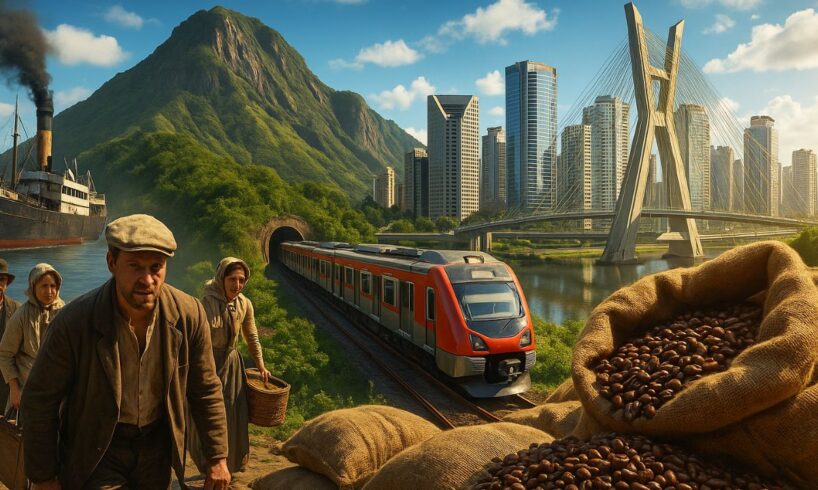
São Paulo emerged from the periphery of the Empire by combining coffee production, the arrival of immigrants, the expansion of the railroad, and industrialization, becoming the richest state in Brazil.
For a long time, São Paulo was far from being synonymous with wealth, power, and prominence.About 200 years ago, the province was merely a secondary player in a relatively poor Brazil, without significant economic or political influence. In 1872, the capital had about 30 inhabitants; it was only the ninth largest city in the country, smaller than Belém and much smaller than Rio de Janeiro, which concentrated population, money, and prestige.
In less than a century, however, everything turned upside down. São Paulo transformed from a relatively poor, peripheral region into a population, industrial, and financial center., becoming the economic engine of Brazil. To understand this historical turning point, it is necessary to look at a set of interconnected factors: geography, transportation, coffee, immigrants, politics, and, above all, strategic decisions made by local elites over time.
From the periphery of the Empire to the beginning of the turning point.
After the arrival of the Portuguese in Brazil, São Paulo spent centuries in decline, almost erased from the national scene.For about 300 years, the province was not among the poorest, but it was far from leading the way. Other regions were gaining prominence in the Empire’s economy, especially those linked to large exports.
— ARTICLE CONTINUES BELOW —
Bahia, Pernambuco, and Maranhão were examples of wealthy provinces, sustained by products that were exported in large volumes. Maranhão exported cotton, while Bahia and Pernambuco dominated the sugar industry.generating wealth, political influence, and a presence in international trade. São Paulo also produced sugar, but on a much smaller scale, exported little, and therefore occupied a secondary place in the economic hierarchy.
More serious, in the view of many people from São Paulo at the time, is that São Paulo was seen as a kind of suburb of Rio de Janeiro.São Paulo, the capital of the Empire and center of political power. The idea of a “state” as we know it today did not yet exist; the country was divided into provinces, and São Paulo was neither among the richest nor the most influential.
The mountain wall and the mule toll.
If the soil was fertile and the export model worked in other regions, why São Paulo did not follow the same path with sugar and cotton.The answer lies in geography. Between the productive interior and the coast, where the ports were located, there was a gigantic obstacle: the mountain range.
This mountain range was so steep and difficult to cross that the Portuguese began to call it “The Wall”. For centuries, transportation was done along narrow trails, many of which were opened and used by indigenous peoples, making the flow of goods slow, expensive, and limited.This increased production costs and hampered any attempt at large-scale expansion.
At the end of the 18th century, the first road linking the plateau to the coast appeared. It was narrow, winding, and had 133 curves from the top of the mountain range to the coastal region. Even so, This road represented a huge advance over the old trails and paved the way for an economic transformation.Brazil was starting to plant coffee, and São Paulo was about to enter the market in earnest.
In this context, the first major strategic movement that would help São Paulo become wealthy was born: the creation of the mule tollWith the growth of coffee cultivation, transportation was done by mule trains, carrying loads for many days. Feeding these animals was expensive, and corn served as the “gasoline” of the time.
Coffee, tolls and railroadThe economic takeoff of São Paulo
In 1831, Dom Pedro I abdicated the throne. Shortly after, the provinces gained more autonomy, and the city of São Paulo makes a fundamental decision: to create dozens of tolls along the mule train routes.Anyone passing by on the road with 10 or 20 mules loaded with sugar or other goods had to pay a fee per animal, something like 200 réis per mule.
This money didn’t just sit idle. The toll revenue was used to build better, wider, and more passable roads.This reduced transportation costs and time. This allowed coffee, which previously was only worthwhile to plant near the coast, to begin expanding into more distant areas of the interior of São Paulo state.
A few decades later, the great revolution would arrive: the railroad. The railway received direct investments from coffee producers because it was the route by which the produce would reach Santos and, from there, the rest of the world.By making transportation cheaper and faster, the railroad allowed coffee plantations to spread across large areas of the state, boosting the founding of cities around the stations and multiplying production.
At this point, geography begins to “play in our favor”: São Paulo solves its transportation problem, takes advantage of the growing international demand for coffee, especially from countries like the United States, and converts this advantage into concrete wealth.From there, the state embarks on a growth trajectory that extends far beyond the agricultural sector.
Immigrants, the end of slavery, and the birth of industrialization.
With coffee cultivation expanding and production increasing, a problem arose: who would work in the fields? The farms in São Paulo needed a large workforce precisely when the country prohibited the trafficking of enslaved people from Africa.which changed the dynamics of work.
For a time, there was what was called internal trafficking: enslaved people were transferred from the Northeast to regions like Rio de Janeiro and São Paulo. But this system became economically unviable, at the same time as the abolitionist movement and the resistance of the enslaved people themselves gained strength. The situation became unsustainable.
Faced with this impasse, The elite of São Paulo make another crucial decision: to encourage the arrival of mass immigrants.In less than 100 years, more than 3 million people passed through the former immigrant hostel in São Paulo. Many came from Japan and regions such as present-day Lebanon and Syria, but most came from Europe.
In Europe, the crisis was profound. Crop losses due to pests and weather, famine, economic crisis, and wars such as the unifications of Germany and Italy pushed millions out of their countries.It was a desperate population, willing to take a risk in a distant and unknown country to try to start over.
With the arrival of these immigrants, São Paulo now has a different economy from the rest of Brazil.based on wage labor. At the end of the 1880s, slavery ended. In São Paulo, Italian immigrants began to be hired with cash wages, which created a domestic consumer market.
This wage-earning workforce could afford to buy fabrics, food, and basic goods. At this time, the foundations for an industrialization aimed at supplying this new domestic demand began to emerge in São Paulo., replacing some of the imports. The wealth from coffee is converted into capital, infrastructure and factories, and the state begins to gain industrial strength.
With so much money circulating, The elites of São Paulo came to dominate not only the economy, but also national politics, in alliance with Minas Gerais.Thus was born the so-called “Coffee with Milk Republic”: São Paulo led in coffee production, while Minas Gerais accounted for about half of the milk sold in the country at the beginning of the 20th century.
This hegemony lasted for several decades, until the international landscape changed. The 1929 crisis caused demand for coffee to plummet, resulting in low prices.putting significant pressure on the São Paulo economy, which is dependent on exports.
In 1930, Getúlio Vargas assumed power, reduced the autonomy of the states, appointed federal intervenors, and governed without a constitution. The elites of São Paulo reacted with an armed revolt in 1932.Supported by local economic and political groups, troops from São Paulo clashed with federal forces and were ultimately defeated.
Even so, according to experts, São Paulo manages to turn defeat into opportunity.Instead of simply lamenting, the elite of São Paulo invested in the creation of USP (University of São Paulo). With this, the state not only consolidated its economic strength, but also became a hub for knowledge production and the training of qualified professionals.
Protectionism, industry, and the leading edge that reaches the 21st century.
In the 1930s, Brazil faced difficulties importing manufactured goods. The response was the adoption of policies to protect domestic industry. This new environment directly benefits São Paulo, which already had accumulated wealth from coffee, infrastructure, and a salaried working class ready to consume..
Throughout the 20th century, This combination of favorable geography, structured transportation, accumulated capital, immigrants, industries, and political decisions consolidates São Paulo’s economic leadership.…which continues to lead the way in the present day. The state has become a major center for services, finance, technology, industry, and academic production.
But this trajectory also has contradictions. Experts warn that the idea of São Paulo’s superiority over other states is dangerous.This is especially true when linked to the narrative of the Europeanization of the São Paulo elite. This elite, built upon racial and hygienist theories, often saw itself as a kind of “Europe” surrounded by a Brazil that should be ruled.
According to sociologist Jessé Souza, São Paulo used symbolic power to legitimize its political and economic power.…building a narrative in which the state would be naturally more advanced or more “civilized” than the rest of the country. Convincing others of this would be part of the game of maintaining and expanding this leadership.
Internal migrations, diversity and São Paulo today
The history of São Paulo was not built solely by foreign immigrants, but also by millions of Brazilians from other regions.especially from the Northeast. At one point, the number of internal migrants arriving in the state exceeded the number of foreigners.
Many people who came from the Northeast started working in construction, factories, and services, literally helping to build the city and sustain its industrial and urban growth. According to the 2022 census, more than 5 million people living in São Paulo were born in the Northeast of Brazil., which represents more than 11% of the state’s population, not counting children and grandchildren who were born on São Paulo soil.
The peak of this migration occurred in the 1970s and 1980s, and the impact was enormous not only on the economy but also on the culture. The São Paulo of today is a direct result of this intense mix of peoples, accents, cultures, and trajectories., which transformed the capital and the state into a mosaic of identities.
In short, São Paulo became rich because it solved a transportation problem, capitalized on the coffee boom, invested in railroads, attracted immigrants, created a salaried working class, boosted industrialization, and knew how to use politics and institutions to its advantage.Geography and transportation costs matter, but the historical decisions of elites also weigh heavily in this equation.
And you, looking at this trajectory of São Paulo, Which part of the story surprises you the most or sparks your curiosity to comment on?





